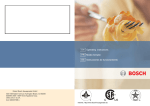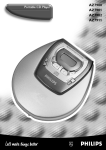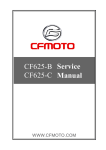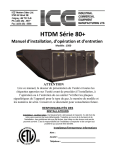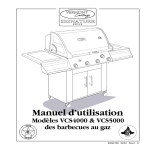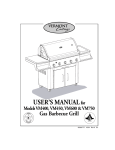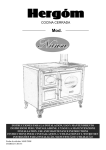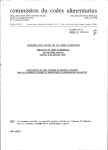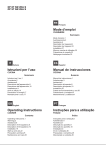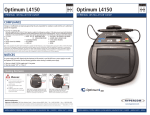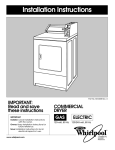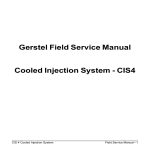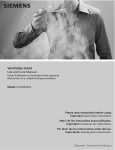Download EN Operating instructions FR Mode d`emploi ES
Transcript
EN Operating instructions FR Mode d’emploi ES Instrucciones de funcionamiento Siemens - Electrogeräte GmbH 5551 McFadden Avenue, Huntington Beach, CA 92649 866/447-4363 • BSH Home Appliance Corp. 2002 Litho in U.S.A. Code. 9000255809 A Dear Customer, We thank and congratulate you on your choice. This practical, modern and functional appliance has been built with top quality materials. These materials have been subjected to thorough quality control in the manufacturing process, and meticulously tested in order for this appliance to meet your every need, achieving perfect cooking. Therefore, we ask you to read and follow these simple instructions in order to guarantee unbeatable results from the first use. This manual contains important information, not only for use of the appliance, but safety and maintenance as well. During transport, our products are protected by efficient packaging materials. However, we have reduced our packaging to the bare essentials. The materials are all completely recyclable. Just like us, you can help protect the environment. To do so, we recommend you dispose of these materials in the recycling facility nearest you. Waste oil should not be poured down the sink drain, as this has a negative impact on the environment. Place it in a closed container and dispose of it at a collection point. If this is not possible, dispose of it with standard domestic waste (as it will be taken to a controlled landfill, and though this is not the best solution, at least water pollution will be avoided). Present and future generations will appreciate it. Before you get rid of an old appliance, make sure you render it inoperable. Next, deliver it to a recyclable material collection facility. Your local government can provide you with the necessary information on the nearest collection facility. 1 2 FOR YOUR SAFETY 3 Important information for installation and usage 4 Important instructions For your safety Before set-up For appliance usage 6 6 9 9 This is what your new cooktop looks like 10 Gas burners Cooking tips Appropriate cooking utensils 11 12 12 Cooktop usage warnings 13 Advice on using the appliance 14 Home troubleshooting 16 Installation instructions Installing the cooktop on the kitchen unit: Fitting measurements Electrical connection Change of gas type: from natural gas to propane Convert the pressure regulator: from 6” W.C. to 10” W.C. 17 17 19 20 23 Warranty conditions 24 For your safety WARNING: If the information in this manual is not followed exactly, a fire or explosion may result causing property damage, personal injury or death. Do not store or use gasoline or other flammable vapors and liquids in the vicinity of this or any other appliance. WHAT TO DO IF YOU SMELL GAS Do not try to light any appliance. Do not touch any electrical switch. Do not use any phone in your building. Immediately call your gas supplier from a neighbor's phone. Follow the gas supplier's instructions. If you cannot reach your gas supplier, call the fire department. Installation and service must be performed by a qualified installer, service agency or the gas supplier. PLEASE READ THE INSTRUCTIONS BEFORE CONTINUING IMPORTANT: Keep these instructions for the local electrical inspector to use. INSTALLER: Leave these instructions next to the unit for the owner. OWNER: Keep these instructions for future use. 3 Important information for installation and usage 1 - For safety reasons, do not allow the flames to extend beyond the edge of the cooking appliance. 8 - The gas pressure regulator supplied with the appliance must be installed in the gas piping line. 2 - Remember that the appliance heats up when in use. Remember to use common sense.The absence of a flame does not mean that the appliance parts are no longer hot. 9 - The appliance and its individual shutoff valve must be disconnected from the gas supply piping system during any pressure testing of the system at test pressures in excess of 3.5 kPa (1/2 psig).The appliance must be isolated from the gas supply piping system by closing its individual manual shutoff valve during any pressure testing of the gas supply piping system at test pressures equal to or less than 3.5 kPa (1/2 psig). 3 - For safety reasons, this appliance should not be used for room heating purposes. 4 - Make sure the power supply is disconnected before dismantling the appliance. 5 - Do not store combustible materials, such as gasoline, other vapors and inflammable liquids near the appliance. 6 - Do not block the combustion or ventilation air flow. •If a burner goes out and gas escapes, open windows and doors. Wait until gas dissipates before using the appliance. 10 - Important:When using an especially large pan, leave a minimum space of 50 mm (2") to prevent damage to countertops of wooden, plastic or other non-heat resistant materials. Never leave hot oil or grease unattended. 11 - Make the caution about leaving oil or grease unattended. •Always turn hood ON when cooking at high heat or when flambeing food (i.e. Crepes Suzette, Cherries Jubilee, Peppercorn Beef Flambe'). •If you smell gas, your installer has not done a proper job of checking for leaks. If the connections are not perfectly light, you can •Use high heat settings on the cooktop only have a small leak and, therefore, a faint smell. when necessary. To avoid bubbling and Finding a gas leak is not a "do-it-yourself" splattering, heat oil slowly on no more than procedure. Some leaks can only be found with a low-medium setting. Hot oil is capable of the burner control in the ON position and this causing extreme burns and injury. must be done by a qualified service technician. See Warning, page. 3. •Never move a pan of hot oil, especially a deep fat fryer. Wait until it is cool. 7 - Maintain a minimum distance of 762 mm (30") between the gas cooktop and cabinets installed in the upper part. 4 This appliance has been tested in accordance with ANSI/CSA Z21.1 Standard for household Cooking Appliances (USA) and CAN 1.1-M81 (Canada) For US installations only: After a spill or boilover, turn off the burner and This installation must comply with local allow the cooktop to cool. Clean around the burcodes, or if none exists, the National Fuel ner and burner ports. After cleaning, check for Gas Code, ANSI Z 223.1/NFPA 54, current proper operation. edition. If an external electrical source is used, the Use Proper Pan Size. The use of undersized appliance must be electrically grounded in cookware will expose a portion of the heating compliance with local codes, or if none element or burner to direct contact and may result exists, the National Electrical Code in ignition of clothing. Select cookware having ANSI/NFPA 70, current edition. flat bottoms large enough to cover the surface For Massachusetts installations: unit. This appliance is equipped with one or 1. Installation must be performed by a more surface units of different size. Proper relaqualified or licensed by the state, province tionship or cookware to heating element or or region where this appliance is being burner will also improve efficiency. installed. 2. Shut-off valve must be a "T" handle gas 13-To avoid compromising the electrical cock. safety of the appliance, use of high-pressure 3. Flexible gas connector must not be steam jet cleaning apparatus is forbidden. longer than 36 inches. The name plate is affixed to the For Canada installations only: underside of the appliance. The installation must comply with CAN 1B149.1 and .2- Installation Codes for Gas Burning Appliances and or local codes. WARNING: NEVER use this appliance When installed, the appliance must be as a space heater to heat or warm the electrically grounded in compliance with local room. Doing so may result in carbon legislation, or if none exists, in compliance monoxide poisoning and overheating of the oven. with CSA Standard C22.1-Canadian Electrical Code, Part I (current). 12 - Do not clean the appliance while it is still hot. Some cleaners produce noxious fumes when applied to a hot surface. Wet clothes or sponges can cause burns from steam. 5 Important instructions For your safety Carefully read this Operation and Maintenance Manual before using your new cooktop. As its user, you are responsible for the proper maintenance and use of this appliance in your home. WARNING: These precautions will reduce the risk of burns, electrocution, fire and personal injury. Proceed with maximum care when using this cooktop, as this appliance generates intense heat and can increase the risk of accidents. When using cooking appliances, the following basic safety precautions must be observed: • Ensure proper installation and service. Follow the installation instructions provided with this product. Only a qualified technician can perform the installation and grounding of the cooktop. Do not use the appliance if damaged. • Have the installer show you where the gas shut-off valve is located, to know how and where to shut off the gas mains to the cooktop. • To prevent carbon monoxide build-up, do not block appliance air vents. • Do not repair or replace any part of the appliance unless it is specifically recommended in this manual. All remaining service must be performed by a qualified technician. 6 • It is prohibited to leave children alone or without adult supervision in an area where appliances are in use. It is prohibited for anyone to sit or stand on any part of the appliance. When children become old enough to operate the appliance, it is the legal responsibility of the parents or legal guardians to ensure that they are instructed in safe practices by qualified persons. • Do not allow children to use this appliance unless closely supervised by an adult. Children and pets should not be left alone or unattended in the area where the appliance is in use. They should never be allowed to play in its vicinity, whether or not the appliance is in use. • Do not place objects that may attract children's interest on or behind the cooktop. If children climb up the appliance to retrieve such objects, they could be seriously injured. • Do not use aluminium foil or protective liners to line any part of an appliance, especially surface unit drip bowls or oven bottom. Installation of these liners may result in a risk of electric shock or fire. • Do not allow aluminum foil, plastic, paper or cloth to come in contact with a hot burner or grate. Do not allow pans to boil dry. • Do not use any part of the cooktop to store objects. Inflammable materials can ignite and plastic objects can melt or catch fire. • Extinguish flames with a properly fitted lid, baking sheet or other metal tray. Next, attempt to shut off the gas burner. Use caution and avoid burns. If flames are not extinguished immediately, evacuate the premises and notify the fire department. • When connecting electrical appliances near the cooktop, make sure that the cables do not touch any cooking surface that remains hot. • If the cooktop is near a window, ensure that the curtains can not be blown or moved over or near the burners of the cooktop, as this could trigger a fire. WARNING-TO REDUCE THE RISK OF A GREASE FIRE: a) Never leave surface units unattended at high settings. Boilovers cause smoking and greasy spillovers that may ignite. Heat oils slowly on low or medium settings. b) Alway turn hood ON when cooking at high heat or when flambeing food (i.e. Crepes Suzette, Cherries Jubilee, Peppercorn Beef Flame). c) Clean ventilating fans frequently. Grease should not be allowed to accumulate on fan or filter. d) Use proper pan size. Always use cookware appropriate for the size of the surface element. Smother flames from food fires other than grease fires with baking soda. Never use water on cooking fires. Have an appropriate fire extinguisher avai lable, nearby, highly visible and easily accessible near oven. WARNING-TO REDUCE THE RISK OF INJURY TO PERSONS IN THE EVENT OF A GREASE FIRE, OBSERVE THE FOLLOWING: a) SMOTHER FLAMES with a close-fitting lid, cookie sheet, or metal tray, then turn off the burner. BE CAREFUL TO PREVENT BURNS. If the flames do not go out immediately. EVACUATE AND CALL THE FIRE DEPARTMENT. b) NEVER PICK UP A FLAMING PAN- You may be burned. c) DO NOT USE WATER, including wet dishcloths or towels - a violent steam explosion will result. d) Use an extinguisher ONLY if: 1) You know you have a Class ABC extinguisher, and you already know how to operate it. • For your personal safety, wear the proper clothing. Do not wear loose garments, or any with drooping sleeves while using this appliance. Some synthetic fabrics may easily catch fire and should not be worn while cooking. In the event that personal clothing catches fire, drop and roll immediately to smother the flames. • This appliance has been designed for the cooking of food. For safety reasons, never use the cooktop to heat a room. • This appliance is intended for normal family household use only. It is not approved for outdoor use. See the Warranty. If you have any questions, contact the manufacturer. • When using the cooktop: DO NOT TOUCH THE BURNER GRATES OR THE IMMEDIATE SURROUNDING AREA. They heat up enough to cause burns. • WARNING: To prevent flare-ups all grates must be properly positioned on the cooktop whenever the cooktop is in use. Each of the feet must be placed into the corresponding dimples in the cooktop. Do not use a grate if damaged. • Never leave the cooktop unattended. Spillovers will cause smoke and grease spills that can ignite. • Do not heat food containers without opening them. An accumulation of pressure can trigger the explosion of the container. 2) The fire is small and contained in the area where it started. 3) The fire department is being called. • Do not heat or warm unopened food containers. Build-up of pressure may cause the containers to burst and cause injury. 4) You can fight the fire with your back to an exit. that personal clothing catches fire, drop and roll • Never allow clothing, baking mitts or other inflammable materials to come into contact with a burner or the grate of this appliance, or to remain close to these objects, until they have cooled. The fabric can ignite and cause personal injury. • Use only dry oven mitts. Wet or damp oven mitts can cause steam burns when applied to hot surfaces. Do not use towels or other voluminous linen products as oven mitts. Do not allow oven mitts to touch the hot grates of the burners. • While cooking, adjust the burner control so that the hot flame only touches the bottom of the pot or pan. Do not allow the flame to extend beyond it. • Use caution so that the currents triggered by the forced ventilation openings or fans do not blow the inflammable material toward the flames, or push them so that they extend beyond the edges of the pot or pan. 7 • Always use cooking utensils with flat bottoms big enough to cover the burner. If smaller utensils are used, part of the flame can remain exposed and set clothing on fire. • Only authorized technicians can carry out the necessary service. Technicians must disconnect the electrical power supply before carrying out maintenance operations on this unit. • To reduce the risk of burns, ignition of inflammable materials and unintentional spills, point the handles of the utensils inward, so that they do not hang over adjacent working areas, cooking areas or the edge of the cooktop. • Never modify or alter the construction of the appliance. For example, do not remove leveling legs, panels, wire covers or anti-tip brackets/screws. • To eliminate the risk of burns or fire by reaching over heated surface units, cabinet storage space located above the surface units should be avoided. If cabinet storage is to be provided, the risk can be reduced by installing a hood that projects horizontally a minimum of 5 inches beyond the bottom of the cabinet. • When stirring or turning food, hold the handle of the pot or pan firmly, to prevent it from moving. • GREASE IS INFLAMMABLE. Let hot grease cool before handling it. Prevent the formation of grease build-up. Clean the cooktop following every use. • In order for the burners to ignite and operate properly, keep the burner ports clean. The burner ports must be cleaned follow ing a a spill or when the burner does not ignite, even if the electrical lighters click. Consult the care and maintenance section. • Never pick up a burning pot, as this could cause burns. • Clean the cooktop with care. Avoid steam burn risks: do not use a sponge or damp cloth to clean the cooktop while hot. Some cleaning products produce harmful vapors if applied to a hot surface. Follow the instructions provided by the cleaning product manufacturer. • Ensure that all the cooktop control knobs are set to off and that the cooktop is cool before using any aerosol cleaning product on or around the cooktop. In the presence of heat, the chemical products that produce the spraying action can ignite or trigger corrosion of the metal pieces. • Hidden surfaces may have sharp edges. Use caution when reaching behind or under appliance. 8 • Install a smoke detector in or around the kitchen. • Install a gas shutoff valve near the appliance. It must be easily accessible in an emergency. • The warranty for this appliance does not cover damages caused by non-adherence to these instructions or by any non-authorized modifications. • California, Proposition 65, Danger : The burning of gas cooking fuel generates some by-products, which are on the list of substances which are known by the State of California to cause cancer or reproductive harm. California law requires businesses to warn customers of potential exposure to such substances. To minimize exposure to these substances, always operate this unit according to the instructions contained in this booklet and provide good ventilation to the room when cooking with gas. • During maintenance procedures, remove power and the plug from the outlet and shut off the gas supply. In order to guarantee the electrical safety of the appliance, only authorized technicians can perform the necessary repairs. The right to make technical modifications is reserved. Keep the ventilation channels open. Prolonged use of the appliance with several or all cooking units may require additional ventilation, such as opening a window or a Remove the packaging from the appliance door or more intensive extraction of air with and dispose of it as per local laws. Remember an extraction hood. that there are other accessories in addition to packaging materials. Keep packaging materials To guarantee good combustion, the and plastic bags out of the reach of children. room in which the appliance is installed Check the condition of the appliance before must have a minimum volume of 1240 cft installing it, to ensure that it has suffered no (35 m3 ) and must possess a door that damage during transport. opens outdoors or a window that can opened. Only authorized technical personnel must install and connect the appliance before The use of spit-roasters, pans or grilling its first start-up in compliance with the regulations of the gas supplier companies and stones simultaneously by more than one burner is prohibited, as the accumulation of local. heat could damage the appliance. Turn the control dials to before connecting the appliance to the current supply. If large pots are used, a minimum separation The appliance's serial number is indicated on of approximately 50 mm (2") should be kept the control slip annexed to this manual. For between the pot and peripheral inflammable materials. A minimum separation of some warranty purposes, keep this note together with the usage and assembly instructions. 50 mm (2") should be kept between the control dial or control panel and the pot or Carefully read the assembly and usage pan. The cooking pot must not touch instructions before starting up the appliance. the control panel. Before the first start-up Thoroughly clean the appliance and accessories when using them for the first time. This will eliminate any "new" scents and any remaining dirtiness (see cleaning and care chapter). For appliance usage The use of this gas burning appliance produces a formation of heat and humidity in the area of use. Make sure that the area has proper ventilation conditions. BURNER If pots or pans are removed temporarily, set the stovetop to the minimum setting. This will reduce the risk of suffering burns while working near open flames; in addition to saving gas, thus favoring the environment. If there is a fault in the current supply, do not use the appliance. If the appliance does not work properly, contact the technical service. Ø MINIMUM PAN SIZE Large double-flame burner Ø MAXIMUM PAN SIZE 9” Rapid burner 9” 10” Semi-rapid 6” 8” Auxiliary 5” 6” 9 This is what your new Cooktop looks like Grates Burner up to 3.900 Btu/hr Burner up to 9.800 Btu/hr Burner up to 6.500 Btu/hr Control knobs Large double flame burner up to 20.000 Btu/hr 10 Burner up to 6.500 Btu/hr The gas burners Figure1 : Off : Hi : Low Figure 2 Thermocouple Ignitor Figure 3 _çíÜ êáåÖë EáååÉê ~åÇ çìíÉêF Äìêå ~í Ñìää éçïÉêK There are indications to show which burner each control knob operates. Fig. 1. To light a burner, press the chosen control knob and turn it toward the left, holding it in the maximum setting for a few seconds until the burner is lit, then release it, and adjust to the desired setting. If it does not light, repeat the procedure. CAUTION - All igniters spark when any single burner is turned ON. Do not touch any of the burners when the cooktop is in use. If the ignitor are dirty, this makes the burner harder to light. Therefore, keep them as clean as possible. This cleaning should be performed with a small brush, considering that the ignitor can not withstand any sharp blows. If your cooktop is not fitted with this automatic lighting feature, use a lighter or a match to light the burner. Your cooktop may be equipped with safety thermocouples to prevent gas flow if the burners are accidentally extinguished. Figure 2. To turn on and activate this innovative system, proceed in the same way, but keeping the control knob pressed down until ignition takes place, the flame appears and does not extinguish. If ignition does not take place, repeat the procedure, keeping the control knob pressed down 1-5 seconds. To turn it off, turn the control knob to the right to the correct position . When carrying out this procedure, the ignition system may activate again. This is completely normal. qÜÉ çìíÉê êáåÖ Äìêåë ~í ãáåáãìã éçïÉêI íÜÉ áååÉê êáåÖ Äìêåë ~í Ñìää éçïÉêK qÜÉ áååÉê êáåÖ Äìêåë ~í Ñìää éçïÉêI íÜÉ çìíÉê êáåÖ áë íìêåÉÇ çÑÑK Your modern, functional cooktop has progressive gas valves that make it possible to adjust to the necessary setting between the maximum and minimum flames. The large double flame burner is very practical and convenient for cooking with "paella" pans, Chinese woks (all sorts of Asian dishes), etc. If your cooktop is equipped with a large double flame burner, it will have a valve facilitating independent control of the interior and exterior flame. This revolutionary system makes it possible to select from a wide array of power settings. Working description Fig. 3. The use of the appliance produces heat and humidity in the site where it is installed. Ensure that the kitchen has good ventilation. Keep ventilation channels open or install a mechanical ventilation system (extraction hood). qÜÉ áååÉê êáåÖ Äìêåë ~í ãáåáãìã éçïÉêI íÜÉ çìíÉê êáåÖ áë íìêåÉÇ çÑÑK Prolonged use of the appliance with several or all cooking units may require additional ventilation, such as opening a window (without causing air currents) or increasing the power of mechanical ventilation if it exists. 11 Cooking recommendations Very high High Large Boiling, cooking, roasting, double-flame browning, "paellas" and burner Asian dishes (wok). Medium Low Reheating and keeping food warm: ready and pre-cooked meals. Defrosting. Steaming: fish and vegetables. Rapid Steaks, omelettes and fried dishes. Rice, “bechamel” (sauce) and stew. Semi-rapid Steamed potatoes, fresh vegetables and pasta. Reheating and keeping food warm: pre-cooked meals, preparing delicate casseroles. Auxiliary Cooking: casseroles, rice pudding and caramel. Defrosting and slow cooking: legumes, fruits and frozen products. Melting: butter, chocolate and gelatin. Appropriate cooking utensils Match Pan Diameter to Flame Size - The flame should be the same size the bottom of the pan or smaller. Do not use small pans with high flame settings as the flames can lick up the sides of the pan. Use Balanced Pans - Pans must sit level on the cooktop grate without rocking. - Center pan over burner. Use a lid That Fits Properly - A well-fitting lid shorten the cooking time. 12 Cooking warnings NO YES Do not use small pots on large burners. The flame should not touch the sides of the pot. Always use appropriate pots for each burner. This will prevent excessive consumption of gas and staining of the pots. Do not cook without a lid, or if the lid moves, as this causes a partial energy loss. Always use the lid. Do not use pots with irregular bottoms as they lengthen cooking time and increase energy consumption. Use only pots, pans and casseroles with flat, thick bottoms. Do not place the pot off-center over the burner, as tipping could result. Do not use large-diameter pots on the burners near the control knobs, which, once centered over the burner, could touch the knobs or be close enough to them that the temperature of that area increases, possibly causing damage. Never place pots directly on top of the burners. Center the pot over the burner. Place the pot over the grate. Make sure that the grates and burner covers are in the correct positions before using the appliance. Do not use excessive weights or strike the cooktop with heavy objects. Never use two burners or heat sources to heat a single pot. Avoid using roasting grilles, earthen pots, etc. for extended periods at maximum power. Handle pots carefully when they are on the cooktop. 13 Advice on using the appliance DO NOT Do not use washing powder, oven-cleaning sprays or scourers that might scratch the glass. Never use sharp objects such as metal scourers or knives to remove the hardened remains of food from the surface. Never use a knife, scraper or similar device to clean the area where the glass meets the trim of the burners or the decorative metal frame. Do not slide pans over the glass because they could scratch it. In addition, try not to drop heavy or sharp objects on the glass. Never strike any part of the cooking hob. Grains of sand that may come from cleaning fruits and vegetables will scratch the glass surface. DO After each use, clean the surface of the respective burner parts once they are cold. If any bits are left (overcooked food, drops of grease etc.), however few they will become stuck to the surface and more difficult to remove later. To keep the burners and pan supports clean, you must clean them periodically by placing them in soapy weather and brushing and with a nonmetallic brush to ensure that the holes and grooves are perfectly clean, and can provide a perfect flame. Always dry the burner covers and the pan supports if they have become wet. Use a glass scraper, and always lay it flat to the glass, taking special care not to get it too near to the trim on the gas burners. After finishing cleaning, dry all the burner parts together w ith their casing. T he ring and the burner cap must be inserted w hen placing them on the burner casing. M oisture and the incorrect positioning of the respective burner parts w ill affect the uniformity of the flame generated. Melted sugar and spilt foods that have a high sugar content should immediately be removed from the hotplate using the glass scraper. After washing the pan supports, dry them well before using them to cook again - if there are still any drops of water or damp patches left when you start cooking, they could damage the enamel. When cleaning the pan supports, be careful with the pegs, as they could come loose and scratch the glass or the frame the next time you use the pan support. 14 15 Home troubleshooting You do not always need to call the technical assistance service. In many cases, you can solve problems on your own. The following table contains useful advice. Important: Only authorized personnel from our Technical Service can perform the necessary tasks relative to the gas and electrical systems. What's wrong? Cause Probable Solution - Check the fuse in the general fuse box, and replace it if faulty. -The automatic circuit breaker has - Check the general incoming tripped or a fuse has blown. cabinet for a tripped automatic circuit breaker or blown fuse. The general electrical system is malfunctioning -Defective fuse. The electric ignitor does not work -There is food or cleaning product residue between the ignitor and the burner. -The burners are wet. - The space between the ignitor and the burner must be cleaned carefully. -Dry the burner covers carefully. -The burner caps are not set correctly. - Ensure that the covers have been correctly set. -The different parts of the burner have been set incorrectly. - Correctly set the various parts. - The grooves on the burners' gas outlets are dirty. - Clean the grooves on the burners' gas outlets. -The burners may not be totally dry. - Proceed with thorough drying (take special care with monoblock burners). The gas flow does not appear to be normal or no gas comes out -The gas mains are turned off through a mid-pipe valve. - If the gas comes from a gas bottle, it may be empty. - Open possible mid-pipe valves. There is a smell of gas in the kitchen area -A gas valve has been left on. -Check to see if any gas valve is on. - Ensure that the coupling has been made correctly. The flames on the burners are not uniform -There may be a leak from the coupling to the gas bottle. The safeties of the various burners do not work 16 -Replace the gas bottle with a full one. - The control knob has not been held down long enough. - Once the burner is lit, keep the control knob pressed for a few more seconds. -The grooves on the burners' gas outlets are dirty. - Clean the grooves on the burners' gas outlets. Installation instructions Read these instructions before installing or using the appliance. Thoroughly follow the general safety instructions as well as the important information. Before using the appliance, an authorized technician must install and connect it. Additionally, this technician must ensure that the power supply and gas connections work properly. The technician performing the installation is responsible for the perfect operation of the appliance in its place of installation. The technician must show the user how to disconnect the electricity and gas when necessary. PRECAUTION: Before connecting the appliance, ensure that the local connection conditions as well as the gas type and pressure and the current supply voltage match the appliance's settings. It is necessary for all tasks related with installation, adjustment and adaptation to LP gas to be performed by authorized personnel, and that the codes in force, as well as the requisites of the gas companies, be respected. Before you begin, turn off the gas and electricity supply to the appliance. Before installing, turn power OFF at the service panel. Lock service panel to prevent power from being turned ON accidentally. Before connecting up the appliance to the installation, first check that it has been adjusted for the type of gas that is to be supplied. Our cooktops are delivered from factory fit to work with the gas type indicated on the name plate. It is obligatory for the place where the appliance is to be installed to have standard ventilation. Thus, it is necessary for the combustion gases to be vented outside. IMPORTANT INFORMATION Check the dimensions of the cooktop as well as the dimensions of the hole to be cut in the kitchen unit. The panels located above the work surface, next to the cooktop, must be made of noninflammable material. The stratified coatings and the adhesive that fixes them must be heat-resistant to prevent possible deterioration. Electrical cables must not come into contact with heat zones. The power cable must be fastened to the kitchen unit to keep it from touching the hot parts of the oven or cooktop. It is mandatory for appliances with any electrical component to be grounded. Installer-show the owner the location of the circuit breaker or fuse. Mark it for easy reference. The installation of this appliance must be performed in accordance with the codes in force and only in a well-ventilated site. If required by the National Electrical Code (or Canada Electrical Code), this appliance must be installed on a separate branch circuit. Handle the appliance with care during the entire installation process. Avoid any blows to the appliance. In the event that these recommendations are not observed, the installation technician will be responsible for any damage caused, and the manufacturer will be exempt from all responsability. Installing the cooktop on the kitchen unit: Fitting measurements 1 - Minimum distances (mm). Cut a gap of the required size in the work surface. Fig. 1 a-b Follow the installation instructions for hoods. 2 - The wood fibres that have been used to make the cabinets tend to swell quickly when they come into contact with moisture. Therefore, we recommend to coat the cut surfaces, to protect them from steam or condensed water that could be deposited under the kitchen unit work surface. 17 IMPORTANT INFORMATION Requirements for the cabinet Fig. 1a E C F B D A A- Minimum 6” (152 mm) B- Minimum 6” (152 mm) C- Minimum 30” (762 mm) D- Minimum 2” (51 mm) E- Minimum 36” (915 mm) F- Minimum 18” (458 mm) Maximum depth of cabinets installed above cooktop: 13" (330 mm.) Appliance installation 3 - Depending on the model, the clips and the watertight seal (lower edge of the cooktop) may already be fitted; if this is the case, do not remove them under any circumstance. The seal ensures that the entire work surface will be watertight, and prevents water seepage. If this item has not been fitted in the factory, remove the pan supports and the gas burner covers and diffusers from your cooking hob, and turn it upside down.Now fit the adhesive seal supplied with the appliance onto the lower edge of the cooking hob, Fig. 2a,remove the clips from the attached accessories bag and screw them into the lower points designed for this purpose, Fig. 2 b. Place the cooktop in the middle of the opening where it is to be inserted into the kitchen unit. Once the hob is fitted you should turn the clip and tighten the screw as shown in Fig. 2b. For disassembly, unscrew the clip and proceed in the reverse manner. Note: do not stick the hob onto the worktop with silicone. If the oven is not installed under the cooktop, place a separator of non-flammable material to prevent access to the lower part of the cooktop. To install the cooktop over an oven, check the dimensions given in the installation manual. Figure. 2a min. 71/4” min. 213/16” 331/2” 191/4” min. 6” Fig. 1b Figure. 2b 331/2” 13/4” Figure. 2c 11/16” 11/16” 18 191/4” IMPORTANT INFORMATION All operations relative to installation, adjustment and adaptation to another gas type must be carried out by authorized personnel from our Technical Service, and the codes in force, as well as the requisites of the gas companies must be complied with. 4 - Before connecting the appliance, ensure that the local connection conditions, as well as the gas type and pressure match the settings of the appliance. Ensure that the gas supply is cut off through the manual shut-off valve before connecting the appliance. The gas connection must be in a place that permits access to the manual shut-off valve and that, if necessary, is visible upon opening the kitchen cabinet door. Connect the regulator Figure 3 (2) to the manifold, Figure 3 (1) as shown by the arrow on the regulator applying teflon to the threads. Connect the pressure regulator to the gas grid using a flexible gas line fitting between the shutoff valve and the pressure regulator. Figure 3. Electrical connection Before connecting the power cable to the wall outlet, make sure the gas shut-off valve and all the control knobs of the burners are set to "off". The voltage and total power must be checked on the specifications plate. This appliance must be grounded. Always ensure that all connections have been made in accordance with code requirements. Thoroughly follow the requisites of the local electric power company. The electrical connection (CA 110-127 V) is established by a connection cable with a grounding contact plug connected to a grounded outlet to which there must be access after installation of the gas cooktop. All gas connections must be tested for leaks using an appropriate liquid solution. Never use a flame to test for gas leaks. Figure 3 1 2 Ensure that a bag containing component 2 is supplied with the appliance. If this component is missing, call our Technical Service. Use the parts we supply to complete the gas connection. Tighten the appliance regulador to 15 to 22 ft-lbs of torque. Never tighten to more than 26 ft-lbs of torque. Always use an approved pipe joint compound resistant to the action of LP gas. Connection using a metal pipe. In this case, contact between this tube and the moving parts of the kitchen unit (for example, a drawer) and its passage through areas that could be blocked, must be avoided. The manufacturer accepts no responsibility for leaks or connections carried out by the installation technician. Leak testing of the appliance shall be conducted , according to manufacturer s instructions. WARNING: this appliance is equipped with a three prong grounding plug for your protection against shock hazard and should be plugged directly into a properly grounded receptacle. Do not cut or remove the grounding prong from this plug. The current supply connection cable must be at least of the JT 3x18 AWG/UL/CSA variety, or should be heat-resistant (at least 105 ºC / 221 ºF). The mains connecting cable must only be purchased through and connected by an authorised specialist. Do not tamper with the inside of the appliance. If this is necessary, call our technical assistance service. 19 IMPORTANT INFORMATION Gas type changing: From natural gas to propane It is necessary that all operations related with installation, adjustment or adaptation LP gas be performed by authorized personnel of our Technical Service, and that the regulations in force, as well as the requisites of the gas companies, be followed. IMPORTANT: Before you begin, turn off the gas and electricity supply to the appliance. Before connecting up the appliance to the installation, first check that it has been adjusted for the type of gas that is to be supplied. Our cooktops are delivered from factory prepared to operate with the gas type indicated on the specifications plate. The propane gas tank must be equipped with its own high pressure regulator in addition to the pressure regulator supplied with this unit. Supply Pressure Natural Gas - 7" wc (17.5 mbar) minimum. Propane Gas - 11" wc (27.4 mbar) minimum. The maximum supply pressure to this appliance shall not exceed 14" water column (34.9 mbar). This cooktop can be adapted to work with LP gas. To do so, the following procedures must be completed: A) Change of rapid, semi-rapid and auxiliary cooktop burner tips. (See table1). T ABLE 1 Burner data The burner must be used with the GAS gases indicated on the TYPE specifications plate. Gas pressure for use Burner tip marker Burner rapid Consumption Rated BTU/hr (Hs) Burner tip marker Burner semiConsumption Rated BTU/hr rapid (Hs) Burner tip marker Burner auxiliar Consumption Rated BTU/hr (Hs) Large Burner double flame Burner tip marker Consumption Rated (Hs) BTU/hr NATURAL 6” 138 9.800 110 6.500 85 PROPANE 10” 91 9.800 76 6.500 60 3.900 3.900 184/X 20.000 129/ 20.000 Distance "Y" inner bushing Distance "Z" outer bushing 1 - Remove the grates, covers and the main body of the burner. 2 - Change the burner tips using the spanner provided by our technical services department (code 424699) and make sure that they are tightened all the way in order to ensure that they are correctly sealed. Figure 4. The adjustment of primary air must not be performed on these burners. 20 Fig. 4 IMPORTANT INFORMATION B) Changing the tips on the upper large double flame burner. The glass panel and the frame are fixed to the rest of the cooking hob by means of clips. The following steps must be taken to remove both the glass panel and frames: 1 - Remove all the burners, caps, diffusers, etc. Fig. 5a. 2 - Loosen the two screws on the rapid, semirapid and auxiliary burners. Fig. 5b. 3 - Loosen the three screws on the large double flame burner. Fig. 5c. 4 - Use the disassembly lever 483196 available from our technical assistance service. To release the front clips, apply the lever in the area shown in figures X1, X2, depending on the hob model. Never use the lever on glass edges which have no trim or frame! Before putting the glass back, check that the watertight seals are properly adjusted. 5 - To release the rear clips, carefully raise the entire glass unit along with the frame, as in Fig. X3. Fig. 5 X1 5a 5b X2 X3 6 - Changing the outer flame burner tip. Fig. L. Take out the main burner tip turning it to the left with a 10 mm spanner. At the same time, hold the burner tip casing in the opposite direction with a 13 mm spanner. Fig. K. 5c 21 IMPORTANT INFORMATION K Fig O Unscrew the burner tip Fig. M4 from component Fig. M2 and replace it with the appropriate burner tip as indicated in the burner tip table, and adjust the regulating bushing of the air flow M5 in line with the value indicated in the burner tip table. -Y* If the appliance is not firmly fixed or the clipping system is too rigid, it may cause the entire appliance to lift up. In this case follow this procedure: 1) Loosen the fixing clips of the appliance to the kitchen unit. 2) Loosen the main gas connection and take the appliance out of its seating. 3) Apply the disassembly lever 483196 as shown in Fig. W. Screw in the new main burner tip, pushing the burner tip casing in the opposite direction with a 13 mm spanner. Loosen the holding screw Fig. L1 and set the regulating bushing of the air flow to the value indicated in the burner tip table.-ZTighten the locking screw. 7 - Changing the inner flame burner tip. Fig. M. Using an 8 mm spanner, unscrew the connector Fig. M3 from the threaded component Fig. M2. To do this, hold the threaded component firmly in the opposite direction using a 12 mm spanner. See Fig. N. Then, using a 12 mm spanner, unscrew the threaded component Fig. M2 from the component Fig. M1, holding the latter firmly in the opposite direction with a 12 mm spanner. See Fig. O. L1 M5 M1 L2 M5 M2 M3 Fig W M4 Z Y L Fig N 22 M C) Reduced consumption adjustment of the cooktop burner taps. 1 - Set the taps to the minimum setting. 2 - Remove the control knobs from the taps. Fig. 6. IMPORTANT INFORMATION Fig. 6 Conversion of the 6” W.C. pressure regulator to 10” W.C. Remove the hexagonal lid from the upper part of the regulator with an adjustable wrench. Remove the plastic button on the lid and turn it, pressing it firmly into place so that the letters "LP", instead of "NAT" can be clearly read on the button. Replace the lid and button set on the upper part of the regulator, properly sealing it. Make sure that the spring is in place. Do not over-tighten. NOTE: The arrow on the rear part of the regulator should point in the direction of the gas flow on the cooktop. Fig. 9. Pin position for propane 3 - It has a flexible rubber seal. Simply apply pressure with the tip of the screwdriver to release the thread toward the tap's adjusting screw. Fig. 7. Do not remove the disc seal. Fig. 7 Setting of the pin for natural gas NAT Fig. 9 Hex Cap Hex Lid LP Pin Lid Hex Spring NAT NAT Pin PRESSURE REGULATOR DIAGRAM 4 - Adjust the by-pass screw. Fully tighten the by-pass screw. Fig. 8. Fig. 8 After performing the gas transformation, always ensure that the flame of the burners is correct, so that when changing from the maximum to the minimum setting it does not go out, or cause backflashing. 5 - It is important to ensure the proper placement of all seals in order to prevent any short circuits in case of spillage on the cooktop. 6 - Replace the control knobs on the taps. Never remove the tap shaft. In case of fault, change the whole tap. C) Place the tag indicating the gas type to which the appliance has been transformed over the existing natural gas tag. 23 IMPORTANT INFORMATION If you call the Technical Service Department, please be sure to indicate: E - NR FD This information appears on the appliance name plate, situated on the lower part of the cooktop. WARRANTY COOkTOP WARRANTY WHAT IS COVERED Full One Year Warranty WARRANTY APPLICATIONS This warranty applies to appliances used in residential application; It does not cover their use in commercial situations. This warranty is for products purchased and retained in the 50 states of the U.S.A., the District of Columbia and Canada. The warranty applies even if you should move during the warranty period. Should the appliance be sold by the original purchaser during the warranty period, the new owner continues to be protected until the expiration date of the original purchasers warranty period. For one year from the date of installation or date of occupancy for a new, previously unoccupied dwelling, any part which fails in normal home use will be repaired or replaced free of charge. Save your dated receipt or other evidence of the installation/occupancy date. Siemens will pay for all repair labor and replacement parts found to be defective due to materials and workmanship. Service must be provided by a Factory Authorized Service Agency during normal working hours. For Service Agency nearest you, please phone 866-447-4363. SIEMENS DOES NOT ASSUME ANY RESPONSIBILITY FOR INCIDENTAL OR CONSEQUENTIAL DAMAGES. WHAT IS NOT COVERED SERVICE DATA 1 - Service by an unauthorized agency. Damage or repairs due to service by an unauthorized agency or the use of unauthorized parts. 2 - Service visits to: Some states do not allow exclusion or limitation of incidental or consequential damages, so the above limitation or exclusion may not apply to you. This warranty gives you with specific legal rights and you may also have other rights which may vary from state to state or province to province. For handy reference, the serial tag information has been affixed to the back cover. For location of the serial tag on the product. Keep your invoice for warranty validation. • Teach you how to use the appliance. • Correct the installation. You are responsible FOR REPAIRS OR AUTHORIZED SERVICE. for providing electrical wiring and/or gas installation and other connecting facilities. We want you to be satisfied. If you are not satisfied • Reset circuit breakers or replace home fuses. with the service received, please call 866-4474363 or write us at: 3 - Damages caused from accident, alteration, misuse, abuse, improper installation or installation not in accordance that with local electrical codes or plumbing codes, or improper storage of the BSH Home Appliances Corp. appliance. Customer Support 4 - Repairs due to other than normal home use. 5551 McFadden Ave., Huntington Beach, CA 92649 5 - Any service visits and labor costs during the limited warranty. 6 - Travel fees and associated charges incurred when the product is installed in a location with limited or restricted access (i.e., airplane flights, ferry charges, isolated geographic regions). 24 Any communication must include the model number, serial number and date of original purchase/installation. (See back cover). Cher/chère Client/e : Nous vous remercions et félicitons de votre choix. Cet appareil pratique, moderne et fonctionnel a été fabriqué avec des matériaux de toute première qualité. Ces matériaux ont été soumis à un contrôle de qualité très strict tout au long du processus de fabrication et ils ont été méticuleusement testés afin que ce produit respecte toutes vos exigences dans l'objectif d'obtenir une cuisson parfaite. Nous vous prions donc de lire et de respecter ces instructions très simples pour pouvoir garantir des résultats sans égal dès sa première utilisation. Ce manuel contient des informations importantes, non seulement sur l'utilisation de l'appareil mais aussi sur sa sécurité et maintenance. Pendant leur transport, nos produits sont conditionnés dans un emballage protecteur efficace. En ce qui concerne cet emballage, nous nous limitons à ce qui est absolument indispensable, tout l'emballage étant recyclable. Vous pouvez contribuer à la conservation de l'environnement, comme nous le faisons nous-mêmes. Nous vous recommandons donc de le déposer dans le conteneur le plus proche de votre domicile disposé à cet effet. L'huile utilisée ne doit pas être jetée dans l'évier vu que cela pourrait avoir de graves répercussions sur l'environnement. Déposez-la dans un récipient fermé et apportez-la à un point de collecte ou, à défaut, déposez-la dans la poubelle (elle finira dans une décharge contrôlée, ce qui n’est pas la meilleure solution mais évite la pollution de l’eau). C’est pour le bénéfice de vos enfants et de vous-même. Avant de vous défaire d'un appareil usagé, mettez-le hors d'état. Remettez-le ensuite à un centre de collecte de matières recyclables. Votre administration locale vous fournira les informations nécessaires sur le centre de collecte le plus proche de chez vous. 25 26 POUR VOTRE SECURITE 27 Informations importantes pour l'installation et utilisation 28 Indications importantes Pour la sécurité Avant la première mise en service Pour son utilisation 30 30 33 33 Présentation de votre nouvelle table de cuisson 34 Brûleurs à gaz Conseils pour cuisiner Ustensiles de cuisine appropriés 35 36 36 Avertissements d'utilisation quant à la préparation 37 Avertissements d'utilisation en ce qui concerne : préparation 38 Situations anormales 40 Instructions d'installation Installation de la table de cuisson dans le meuble : Mesures de l'encastrement Connexion électrique Changement du type de gaz : de gaz de ville à propane Transformer le régulateur de pression : de 6” W.C à 10” W.C. 41 41 43 44 47 Conditions de Garantie 48 Pour votre sécurité AVERTISSEMENT : un incendie ou une explosion provoquant des dégâts matériels, des blessures sur les personnes, voire un décès, peuvent découler du non respect strict des informations contenues dans le présent manuel. Ne pas stocker ni utilisez d'essence ni d'autres vapeurs ou liquides inflammables à proximité de cet appareil ou de tout autre appareil électrique. QUE FAIRE SI VOUS DÉTECTEZ UNE ODEUR DE GAZ? Ne cherchez pas à allumer quelque appareil électrique que ce soit. Ne touchez aucune commande électrique, n' utilisez aucun télephone dans le bâtiment. Appelez immédiatement votre fournisseur de gaz depuis le téléphone de votre voisin. Suivez les consignes que vous donnera votre fournisseur de gaz. Si vous ne pouvez joindre votre fournisseur de gaz, appelez les service des pompiers. L' installation et la mise en service doivent être réalisées par un installateur qualifié, une agence spécialisée dans le SAV ou bien par votre fournisseur de gaz. VEUILLEZ LIRE LES INSTRUCTIONS AVANT DE CONTINUER IMPORTANT : Conservez ces instructions pour les fournir à l'inspecteur électricien local. INSTALLATEUR : Joignez ces instructions à l'unité pour remettre l'ensemble au propriétaire. PROPRIÉTAIRE : Conservez ces instructions pour de futures consultations. 27 Informations importantes pour l'installation et l'utilisation 1 - Ne permettez pas que des flammes dépassent le bord de l'ustensile de cuisine. Cette instruction est fondée sur des considérations de sécurité. 2 - N'oubliez pas que l'appareil chauffe lorsqu'il est en fonctionnement. Le sens commun est important. L'extinction des flammes ne signifie par que les pièces ne sont plus chaudes. 3 - Pour des raisons de sécurité, cet appareil ne doit pas être destiné à chauffer une piéce. 9 - L'appareil et sa soupape d'arrêt individuelle doivent être déconnectés du circuit d'alimentation en gaz pendant la réalisation d ' un test de mise en pression du système à des pressions d 'essai excédant 3,5 kPa (1/2 psig). L'appareil doit être isolé du circuit d'alimentation en gaz par fermeture de son robinet d'arrêt manuel individuel pendant la réalisation d'un test de pression du circuit d 'alimentation de gaz à des pressions d 'essai èquivalentes ou inférieures à 3,5 kPa(1/2 psig) 4 - Assurez-vous de déconnecter l'alimentation 10 - Important : quand un récipient très grand électrique avant de démonter l'appareil. est utilisé, laissez un espace minimum de 50 5 - Maintenez la zone de l'appareil propre et mm (2”) pour éviter d'endommager la surface libre de matières combustibles, par exemple du plan de travail de la table de cuisson en essence, autres vapeurs et liquides bois, plastique ou dans d'autres matériaux ne inflammables. résistant pas à la chaleur. Surveillez en 6 - N'obstruez pas le flux d'air de combustion permanence l'huile ou la graisse chaude. et de ventilation. 11 - Veiller à ne pas laisser de l ' huile ou de la •Si un brûleur s' éteint et que du gaz s' échappe, graisse sans surveillance. ouvrir les portes et les fenêtres. Attendre que • Toujours allumer la hotte lorsque vous cuisile gaz dissipe avant d' utiliser la cuisinière. nez à température élevée ou que vous faites • S' il y a une odeur de gaz, l ' installateur n 'a flamber de la nourriture (p.ex. des crêpes pas bien vérifié les fuites a gaz. Si les joints ne Suzette, des cerises jubilées, du boeuf au sont pas parfaitement étanches, il peut y avo- poivre flambé). ir une petite fuite de gaz, et de là, une légère odeur. Trouver une fuite de gaz n' est pas une • Utiliser une température élevée sur la plaque de cuisson seulement lorsque nécessaire. procédure à faire soi-même. Certaines fuites ne peuvent être trouvées qu en plaçant le con- Afin d' éviter les débordements et les éclaboussures, chauffer l' huile lentement à trôle du brûleur en position ON et ceci doit feu pas plus élevé que moyen. L' huile chaude être accompli par un technicien en entretien peut causer des brûlures et des blessures et réparation qualifié. Voir Avertissement, graves. page 24. • Ne jamais déplacer une casserole d' huile 7 - Il faut conserver une distance minimum de chaude, surtout une friteuse. Attendre qu elle ' 762 mm (30”) entre la table de cuisson à gaz soit refroidie. et les armoires placées sur la partie supérieure. 8 - Le régulateur de pression de gaz fourni avec l'appareil doit être installé sur la ligne des tuyaux de gaz. 28 12 - Ne pas nettoyer la cuisinière alors qu'elle est encore chaude. Certains produits nettoyants produisent des vapeurs nocives lorsqu' ils sont appliqués sur une surface chaude. Les linges ou éponges mouillés peuvent causer des brûlures par la vapeur. Aprés un renversement ou un débordement, éteindre le brûleur et laisser refroidir la plaque de cuisson. Nettoyer autour du brûleur et des orifices de combustion. Après le nettoyage, vérifier le bon fonctionnement. Utiliser une dimension appropriée de casserole. L ' utilisation d 'un ustensile de cuisson trop petit expose une partie de l 'élément chauffant ou du brûleur au contact direct et l' ignition des vêtements peut en résulter. Choisir un ustensile de cuisson au fond plat et assez grand pour couvir la surface de l 'elément chauffant. Cette cuisi nière est munie d 'éléments chauffants de différentes dimensions. Adapter la dimension de l 'ustensile de cuisson à la dimension de l ' élément chauffant ou du brûleur augmentera auss l 'efficacité. 13- Pour éviter de mettre en danger la sécurité électrique de l'appareil, il est interdit d'utiliser des appareils de nettoyage à jet vapeur de haute pression. La plaque signalétique se trouve sur la partie inférieure de l'appareil. Cet appareil ne peut être utilisé dans des armoires mobiles, des véhicules de loisirs ou des mobil-home. Cet appareil a été testé conformément aux normes ANSI/CSA Z 21.1 concernant les appareils de cuisson électroménager (USA) et CAN1.1-M81 (Canada) Uniquement si l'installation est effectuée aux USA : Cette installation doit respecter les lois locales ou, à défaut, le National Fuel Gas Code (Loi nationale sur le gaz combustible), ANSI Z 223.1/NFPA 54, édition actuelle. Si vous utilisez une source électrique externe, l'appareil doit être mis à la terre conformément aux lois locales ou, à défaut, au National Electrical Code (Loi électrique nationale) ANSI/NFPA 70, édition actuelle. Installations pour Massachusetts 1. L' installation doit être effectuée par un technicien ou un entrepreneur un plombier qualifié ou avec licence par l' état ou la province ou la région où l' appareil est installé. 2. La soupape d' arrêt doit être un robinet de gaz à poignée en T. 3. Un connecteur de gaz flexible ne doit pas dépasser 36 po. Uniquement si l'installation est effectuée au Canada : L'installation doit respecter le CAN 1-B149.1 et .2- Lois sur l'installation d'appareils à combustion à gaz et/ou les Lois locales. Cet appareil, quand il est installé, doit être mis à la terre conformément aux lois locales ou, à défaut, au CSA Standard C22.1-Loi Electrique du Canada, Partie I actuelle. ATTENTION: NE JAMAIS utiliser cet appareil comme chauffage d' appoint: risque d'intoxication au monoxyde de carbone et de surchauffe de l'appareil. 29 Indications importantes de sécurité Pour la sécurité Lisez attentivement toutes les instructions de ce Manuel de fonctionnement et de maintenance avant d'utiliser votre nouvelle table de cuisson. En tant qu'utilisateur, vous êtes responsable de la maintenance ainsi que de l'utilisation correcte de cet appareil chez vous. AVERTISSEMENT : Ces précautions réduiront les risques de brûlures, d'électrocution, d'incendie et de blessures personnelles. Faites très attention quand vous utilisez cette table de cuisson vu que cet appareil libère une chaleur intense et peut augmenter le risque d'accidents. Quand des appareils de cuisine sont utilisés, il faut suivre les précautions de base suivantes sur la sécurité : • Assurez-vous que l'installation et la mise en service sont correctes. Suivez les instructions d'installation fournies avec ce produit. Seul un technicien qualifié peut réaliser l'installation et la mise à la terre de la table de cuisson. N'utilisez pas l'appareil s'il est endommagé. • Demandez à l'installateur de vous montrer l'endroit où se trouve le robinet d'arrêt du gaz, pour savoir comment et où il faut couper l'arrivée de gaz à la table de cuisson. • Pour prévenir une accumulation de monoxyde de carbone, ne pas bloquer pas les évents d 'aération de l ' appareil. • Ne réparez ni remplacez aucune partie de l'appareil à moins que ce manuel le recommande spécifiquement. Tous les autres services doivent être réalisés par un technicien qualifié. 30 • Il est interdit de laisser des enfants seuls ou sans surveillance dans une zone où des appareils sont utilisés. Ne permettez à personne de s'asseoir ou de rester debout sur une partie de l'appareil. • Dès que des enfants sont en âge d ' utiliser l'appareil, il est de la responsabilité des parents ou des représentants légaux d' assurer qu' ils sont instruits des pratiques de sécurité par des personnes qualifiées. • Ne pas laisser les enfants se servir de la cuisiniére à moins d' être ètre étroitement surveillés par un adulte. Le enfants et les animaux domestiques ne devraient pas être laissés seuls ou sans surveillance près d' une cuisinière en marche. On ne devrait jamais les laisser jouer autour de la cuisinière, qu ' elle soit utilis ou non. • Ne placez pas d'objets éveillant l'intérêt des enfants sur la table de cuisson ou derrière celleci. Si les enfants montent sur l'appareil pour prendre ces objets, ils peuvent souffrir de graves blessures. • Ne pas utiliser de papier aluminium ou de doublure de protection dans quelque partie que ce soit de l 'appareil, surtout les cuvettes de propreté des éléments de surface ou le fond du four. L' installation de ces doublures peut causer un risque de choc électrique ou d' incendie. • Ne pas laisser du papier aluminium, du plastique, du papier ou du tissus venir en contact avec un brûleur chaud ou une grille chaude. Ne pas laisser s' evaporer complètement l ' eau des chaudrons. • N'utilisez aucune partie de la table de cuisson pour ranger des objets. Les matières inflammables peuvent prendre feu et les objets en plastique peuvent fondre ou prendre feu également. • Eteignez les flammes à l'aide d'un couvercle aux dimensions correctes, d'un lèchefrites ou d'un autre plateau en métal puis essayez d'éteindre le brûleur à gaz. Faites très attention et évitez de vous brûler. Si les flammes ne sont pas éteintes immédiatement, évacuez le lieu et appelez les pompiers. • En connectant les appareils électriques près de la table de cuisson, assurez-vous que les câbles ne touchent aucune surface de cuisson chaude. • Si la table de cuisson se trouve près d'une fenêtre, assurez-vous que les rideaux ne peuvent pas voler sur ou près des brûleurs de la table de cuisson et provoquer un incendie. AVERTISSEMENT-POUR RÉDUIRE LES RISQUES D'INCENDIE DE GRAISSE: a) Ne jamais laisser les éléments de surface allumés à haute intensité sans surveillance. Les débordements par bouillonnement provoquent de la fumée et des débordements graisseux qui peuvent prendre feu. Chauffer l' huile lentement à feu bas ou moyen. b) Toujours allumer la hotte lorsque vous cuisinez à température élevée ou que vous faites flamber de la nourriture (p.ex. des crêpes Suzette, des cerises jubilées du boeuf au poivre flambé). c) Nettoyer fréquemment le ventilateur d 'aérotion. Ne pas laisser la graisse s' accumuler sur le ventilateur ou sur le filtre. d) Utiliser la bonne dimension de casserole. Toujours utiliser un ustensile de cuisson d' une dimension appropriée à l' élément de surface. Étouffer les flammes des feux de cuisson autres que les feux de graisse, avec du bicarbonate de soude. Ne jamais utiliser d 'eau sur les incendies de cuisson. Avoir un extincteur approprié à portée de la main, à proximité, très visible et facilement accessible près de la cuisinière. AVERTISSEMENT-POUR RÉDUIRE LES RISQUES DE BLESSURES PERSONNELLES DANS LE CAS D'UN INCENDIE DE GRAISSE, OBSERVER LES CONSIGNES SUIVANTES: a) ÉTOUFFER LES FLAMMES avec une couvercle bien ajusté, une tôle à biscuits ou un plateau en métal, et ensuite fermer le brûleur.ÊTRE PRUDENT POUR ÉVITER DE SE BRÛLER. Si les flammes ne s' éteignent pas immédiatement, ÉVACUER LES LIEUX ET APPELER LE SERVICE D 'INCENDIE. b) NE JAMAIS RAMASSER UNE CASSEROLE EN FEU-Vous pourriez vous brûler. c) NE PAS UTILISER D'EAU, y compris un linge à vaisselle ou une serviette mouillée-il s' ensuivrait une violente explosion de vapeur. d) Utiliser un extincteur SEULEMENT si: 1) Vous savez que votre extincteur est de classe A BC et vous savez déjà comment le faire fonctionner. 2) L' incendie est petit et confiné à l 'espace où il s' est allumé. 3) Quelqu' un appelle le service d' incendie. 4) Vous pouvez combattre l' incendie en ayant le dos vers une sortie. • Faites attention à ce que les vêtements, les gants e cuisine ou d'autres matières inflammables entrent en contact avec un brûleur ou une grille de cet appareil ou qu'ils soient à proximité de ceux-ci, tant qu'ils n'ont pas refroidi. Le tissu peut prendre feu et provoquer des blessures personnelles. • N'utilisez que des gants de cuisine secs. gants de cuisine mouillés ou humides sur les surfaces. chaudes peuvent provoquer des brûlures de vapeur N'utilisez pas de serviettes ni d'autres produits textiles volumineux comme des gants de cuisine. Faites attention à ce que les gants de cuisine ne touchent pas les grilles chaudes des brûleurs. • Par sécurité personnelle, portez des vêtements appropriés. Vous ne devez pas porter de vêtements flottants ni de manches qui dépassent quand vous utilisez cet appareil. Certains textiles synthétiques peuvent prendre feu facilement et ne doivent donc pas être portés pour cuisiner. Au cas oúú vos vêtements prendaient feu, mettezvous à terre et roulez-vous au sol immédiatment pour étouffer les flammes. • Cet appareil a été conçu pour la cuisson d'aliments. Pour des raisons de sécurité, n'utilisez jamais la table de cuisson pour chauffer une pièce vu que l'appareil pourrait s'endommager. • Cette cuisinière est destinée à un usage normal par un ménage familial seulement. Elle n'est pas approuvée pour un usage à l 'extérieur. Voir la garantie. Pour toute question, communiquer avec le fabricant. • Quand vous utilisez la table de cuisson : NE TOUCHEZ PAS LES GRILLES DES BRULEURS OU LES ZONES ENVIRONNANTES. Elles sont suffisamment chaudes pour provoquer des brûlures. • AVERTISSEMENT: Pour prévenir une recrudescence soudaine du feu, toutes les grilles doivent être positionnées correctement sur la plaque de cuisson, chaque fois que celle-ci est utilisée. Chaque patte doit être positionnée dans l' encoche correspondante sur la plaque de cuisson. Ne pas utiliser une grille endommagée. • Ne laissez jamais la table de cuisson sans surveillance. Les débordements produiront de la fumée et des déversements de graisse qui peuvent prendre feu. • Ne chauffez pas de conteneurs d'aliments sans les ouvrir. Une accumulation de pression peut provoquer l'explosion du conteneur. • Ne pas faire chauffer ou réchauffer la nourriture dans un contenant qui n' a pas été ouvert. L' augmentation de la pression pourrait faire exploser le contenant et provoquer des blessures. • Quand vous cuisinez, réglez le contrôle du brûleur de sorte que la flamme chaude ne touche que la partie inférieure du récipient et faites attention à ce qu'elle ne dépasse pas les bords. 31 • Faites attention à ce que les courants d'air provoqués par les ouvertures de ventilation forcée ou de ventilateurs ne soufflent pas la matière inflammable vers les flammes ou poussent les flammes de sorte à ce qu'elles dépassent des bords du récipient. • Utilisez toujours des ustensiles ayant la partie inférieure plate et dont le fond est suffisamment grand pour couvrir le brûleur. Si vous utilisez des ustensiles ayant des dimensions inférieures, une partie de la flamme peut être à découvert et incendier les vêtements. • Pour minimiser le risque de brûlures, d'ignition des matières inflammables et de déversements non voulus, placez les manches des ustensiles vers l'intérieur, de sorte qu'ils ne dépassent pas des zones de travail adjacentes, des zones de cuisson ou du bord de la table de cuisson. • Pour éliminer le risque de brûlure ou d ' incendie en tendant le bras au-dessus d 'éléments de surface chauffés, éviter de placer des armoires de rangement au-dessus des éléments de suface. Si l' on doit placer une armoire de rangement, on peut réduire le risque en installant une hotte qui ressort horizontalement d' au moins 12,7 cm (5 po) au-delà du bas de l 'armoire. • Prenez le manche du récipient pour éviter que l'ustensile se déplace en remuant ou en retournant les aliments. • LA GRAISSE EST INFLAMMABLE. Laissez refroidir la graisse chaude avant d'essayer de la manipuler. Evitez d'accumuler des dépôts de graisse. Nettoyez la table de cuisson après chaque utilisation. • Pour que les brûleurs s'allument et fonctionnent correctement, maintenez propres les sorties. Il faut nettoyer ces sorties quand il s'est produit un déversement ou quand le brûleur ne s'allume pas, même si les allumeurs électroniques font click. Consultez la section sur l'entretien et la maintenance. • Ne soulevez jamais une casserole en feu car vous pourriez vous brûler. • Nettoyez la table de cuisson avec précaution. Evitez les risques de brûlures provoqués par la vapeur ; n'utilisez pas d'éponge ni de chiffon mouillé pour nettoyer la table de cuisson tant qu'elle est chaude. Certains produits de nettoyage produisent des vapeurs nocives s'ils sont appliqués sur une surface chaude. Suivez les instructions fournies par le fabricant du produit de nettoyage. • Assurez-vous d'avoir éteint tous les contrôles de la table de cuisson et qu'elle est froide avant d'utiliser un produit de nettoyage en aérosol sur la plaque de cuisson ou autour de celle-ci. Les produits chimiques produisant l'action de pulvérisation, en présence de chaleur, peuvent prendre feu ou provoquer une corrosion des pièces métalliques. 32 • Les surfaces cachées peuvent avoir des bords tranchants. Être prudent lors du contact avec les parties arrière et en dessous de l 'appareil. • Seuls des techniciens agréés peuvent effectuer les services nécessaires. Les techniciens doivent déconnecter l'alimentation électrique avant de réaliser les services de maintenance de cette unité. • Ne jamais modifier ou altérer l' assemblage de l ' appareil. Par exemple, ne pas enlever les pieds de nivellement, les panneaux, les couvre-fils ou les supports/vis antibasculement. • Installez un détecteur de fumées dans la cuisine ou à proximité. • Installer un robinet d 'arrêt du gaz près de l ' appareil. ll doit être facilement accessible en cas d' urgence. • La garantie de cet appareil ne couvre pas les dommages survenus suite au non respect de ces instructions. Modifications techniques réservées. • Avertissement concernant la California Proposition 65: la combustion de gaz de cuisson génère certains sous-produits qui figurent sur la liste des substances considérées par l'Etat de Californie comme susceptibles de provoquer des cancers ou des lésions des organes reproducteurs. La loi californienne impose aux entreprises d 'avertir les clients du risque potentiel lié à l 'exposition à ces substances. Pour minimiser cette exposition, utilisez toujours l 'appareil conformément aux instructions figurant dans ce manuel et assurez une bonne ventilation de la pièce lorsque vous faites la ' cuisine au gaz. • Pendant la réalisation de processus de maintenance, l'appareil doit être éloigné du réseau de courant électrique. Retirez à cet effet la fiche du réseau ou actionnez la protection correspondante. Fermez l'alimentation de gaz. Pour pouvoir garantir la sécurité électrique de l'appareil, seuls des techniciens agréés pourront réaliser les réparations correspondantes. Droit de réaliser des modifications techniques réservé. pièce où il est placé. Assurez-vous que la pièce incorpore les conditions de ventilation appropriées. Maintenez ouverts les canaux de ventilation. L'utilisation prolongée de l'appareil avec Retirez l'emballage de l'appareil et éliminez-le plusieurs groupes ou avec tous les groupes de conformément aux réglementations locales. cuisson peut demander une ventilation N'oubliez pas qu'il existe d'autres accessoires supplémentaire, comme l'ouverture d'une en plus de l'emballage. Maintenez les éléments fenêtre ou d'une porte ou une extraction d'air de l'emballage et les revêtements en plastique plus intense à l'aide d'une hotte aspirante. hors de portée des enfants. Pour garantir une bonne combustion, la Vérifiez l'état de l'appareil avant de l'installer pièce où se trouve l'appareil doit avoir un pour vous assurer qu'il ne s'est produit aucun volume minimal de 1240 cft (35 m3) et dommage pendant son transport. posséder une porte donnant sur l'extérieur ou une fenêtre pouvant s 'ouvrir. Seul un personnel agréé pourra installer l'appareil et le connecter avant la première mise en service conformément aux réglementations en vigueur Il est interdit d'utiliser simultanément des rôtissoires, des poêles ou des pierres pour gril des entreprises fournissant le gaz et à la chaudes sur plusieurs brûleurs vu que réglementation locale sur les travaux civils. l'accumulation de chaleur pourrait endommager Tournez les manettes de commande sur avant l'appareil. de connecter l'appareil au réseau électrique. Si des casseroles ayant de grandes dimensions Le numéro de série de l'appareil se trouve sur sont utilisées, il faudra maintenir une séparation minimum d'environ 50 mm (2”) entre la la note de contrôle jointe au présent manuel. Pour des raisons de garantie, conservez cette casserole et les matériaux inflammables périphériques. Entre la manette de commande note avec les instructions d'utilisation et de ou le bandeau de commande et la casserole montage. ou la poêle, il faudra maintenir une séparation Lisez attentivement les instructions de montage minimum d'environ 50 mm (2”). Le récipient de et d'utilisation avant de mettre en marche votre cuisson ne devra pas toucher le bandeau de commande. appareil. Avant la première mise en service Nettoyez consciencieusement l'appareil et les accessoires quand vous les utilisez pour la première fois. Vous éliminerez ainsi les possibles odeurs à neuf et les restes de poussière (consultez le chapitre sur le nettoyage et l'entretien) Si les casseroles ou les poêles sont retirées momentanément, placez la table de cuisson sur la graduation minimum. Ainsi sera réduit le risque de brûlures en travaillant à côté de flammes ouvertes ; de plus, la consommation de gaz sera économisée ce qui favorisera l'environnement. Pour son utilisation S'il se produit un défaut d'alimentation, l'appareil ne devra pas être utilisé. L'utilisation d'un appareil de cuisson à gaz produit Si l'appareil ne fonctionne pas correctement, la formation de chaleur et d'humidité dans la contactez le service technique. BRULEUR Ø MINIMUM RECIPIENT Grand brûleur à double flamme Ø MAXIMUM RECIPIENT 9” Rapide 9” 10” Semi-rapide 6” 8” Auxiliaire 5” 6” 33



































